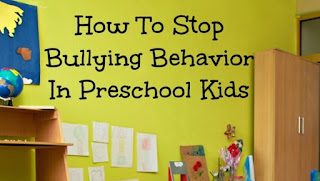Bullying is a very important topic that many parents think
they don’t have to deal with until their children enter school. I,
unfortunately, thought this way until recently when my three-year-old daughter
was confronted with bullying behavior from an older child. Over the last few
months, my daughter has been given more independence to play outside with the
neighborhood kids. And for the most part, she has hours of fun and plenty of
exercise. Until one day, I noticed the language of intimidation and menace in one
older girl’s voice. My little girl had a look on her face that she didn’t
understand why this girl was treating her like she was. Then I realized that I
had to tackle this problem a lot sooner than I thought.
Everyone knows what a bully is. We probably have all
experience at least one person who terrorized us on purpose. When most people
think of bullying, they think of the physical pushing, shoving and punching one
can suffer. More and more, we now realize that bullying is psychological as
well. Bullying is someone using power over another, gaining control through
fear and usually occurs with an audience. Bullying will often occur over
and over until the child and the witnesses are powerless to stand up and fight
back. There is three types of bullying. The physical bullying that everyone is
familiar with. The verbal bullying which includes threats, taunting, hurtful
teasing and hate speech. And social bullying which includes the intentional
excluding from a group and spreading rumors. Bullying has become a bigger problem online as people are using the anonymity of the internet to hurt and terrorize others.
Bullying can begin as early as
three years old and 1 in 5 students in the US classrooms will experience
bullying. Children often bully
because it solves their social problems. The proverbial “easy way out.”
Bullying is often in place of social skills that a person fails to learn in
their developmental stages. Individuals who do not learn how to work out their
problems or get along with others. Bullying can be a natural response to
situations in which an individual feels socially awkward, insecure, frightened,
bored or embarrassed. Bullies often will target children who cry, get mad or
give in easily. They will learn a child’s weakness and press that button until
they get the reaction they want.
How can you know if your child is the victim of bullying?
Children who are bullied will often:
- Have damage or loss of items that he or she cannot explain
- Have physical signs such as scratches or bruises
- Have a loss or change in friends
- Have a sudden loss of interest in activities
- May be unusually sad, moody, anxious, angry or depressed
- May have physical complaints such as headaches and stomachaches to avoid school or other activities
- May start doing poorly in school
What can parents do to teach their children about bullying?
First, take it very seriously either your child is the bullied or the bully,
something is wrong which needs to be addressed. If your child is the bully,
there needs to be a set accountability for their actions, consequences will
happen if they chose to engage in bullying. Second, parents need to communicate
on their level. Look the child in eye, so they can understand that their
actions and words can be hurtful. I find that my daughter and her friends will
respond better to my warnings or instructions when I bring my eye level to
theirs instead of them looking up to mine. Third, remove the child from the
situation and find out the triggering incident. Help children understand that
bullying is wrong wither its being the bullied, the bully or the witness. Lastly,
be a role model for children. Children are great watchers and will respond to
what they see rather than they are told. Show them how not to be bully, how to
respond to bullies and how to help others who are being bullied and they will
follow suit.
How to teach children to respond to bullies:
- Look bullies in the eye
- Stand calm and tall
- Walk away
- Speak in a firm and confident voice
- Teach a child when and how to ask for help and not to be afraid to seek the help of an adult
- Encourage cooperative play and friendships. Children who are loners are more likely to be bullied.
It is unfortunate that once a child learns to
be a bully, they will most likely with always be a bully. They will grow up to
a teenage bully and even an adult bully. And once a child is bullied, they will be bullied in some form for the rest of their life. Unless, we teach our children how to respond
to bullies as well as teach that bullying behaviors are unacceptable. Parents need to help children learn the skills they
will need to handle situations they will encounter in their lives. It may sound
strange but I know that teaching my daughter how to deal with conflict in the
proper manner will help her in school and her adult relationships wither it be
her friendships, colleagues and in her marriage. I know bullying will be a
lifelong lesson as she interacts with different people in her life. Parents, we
are our children first and greatest teacher.
Resources:
American Academy of Pediatrics www.healthychildren.org
Children’s Safety Network: www.childrenssafetynetwork.org/guides/bullying-prevention
The Bully Project: www.thebullyproject.com
How to Stop Bullying Behavior in Preschool Kids: www.ourfamilyworld.com
Empowering Parents: www.empoweringparents.com
There are also a great numbers of books available for
parents and children on bullying. Here are just a few:
Bullying Hurts: Teaching Kindness by Lester L. Laminack and
Reba M. Wadsworth
Words Wound by Justin Patchin
The Berenstain Bears and the Bully by Stan and Jan
Berenstain
The Juice Box Bully by Sornson and Dismandy






No comments:
Post a Comment